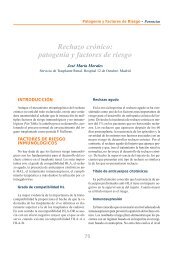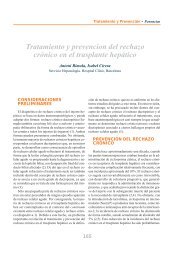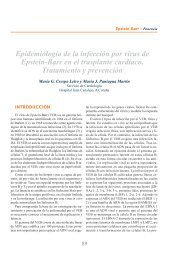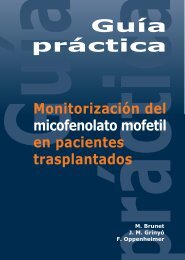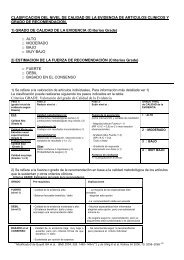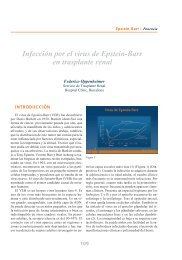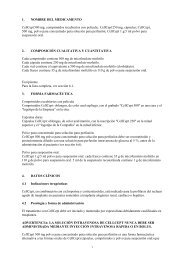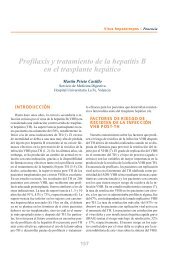Untitled - Roche Trasplantes
Untitled - Roche Trasplantes
Untitled - Roche Trasplantes
Create successful ePaper yourself
Turn your PDF publications into a flip-book with our unique Google optimized e-Paper software.
EARLY DIAGNOSIS OF CHRONIC<br />
ALLOGRAFT NEPHROPATHY<br />
BY MEANS OF PROTOCOL<br />
BIOPSIES<br />
J. Chapman<br />
ROLE OF PROTOCOL BIOPSY EARLY<br />
AFTER TRANSPLANTATION<br />
The term “protocol biopsy” implies, in the context of renal transplantation, that biopsy<br />
is undertaken as a result of a pre-determined protocol and not because of a clinical event<br />
that has lead to the “need” for biopsy. The two processes have lead to very different<br />
answers over the years of development of renal transplantation. The clinically driven<br />
biopsy leads to a self-perpetuating result. Since biopsy is only performed at times of renal<br />
dysfunction, the results lead to the ability to distinguish between different causes of<br />
dysfunction –which essentially means distinguishing types of acute rejection from each<br />
other and from acute calcineurin inhibitor toxicity, or rare cases of pyelonephritis or vascular<br />
catastrophe. The clinically driven biopsy has not allowed distinction between the<br />
appearance of the kidney in times of acute dysfunction and times of stable function. It<br />
has been illuminating, and still remains surprising to some, that the histological data<br />
derived from protocol biopsies taken at times of stable function show a similar range of<br />
appearances to clinical biopsies. It has also required protocol biopsies to understand that<br />
the functional changes in renal allografts dramatically underestimate the severity of the<br />
pathological damage.<br />
This chapter reviews the principles upon which the data are accrued from renal allograft<br />
biopsies specifically to understand the evolution of chronic allograft nephropathy (1, 2). It<br />
is possible to use these data to build and then test a model for understanding the pa-<br />
13




